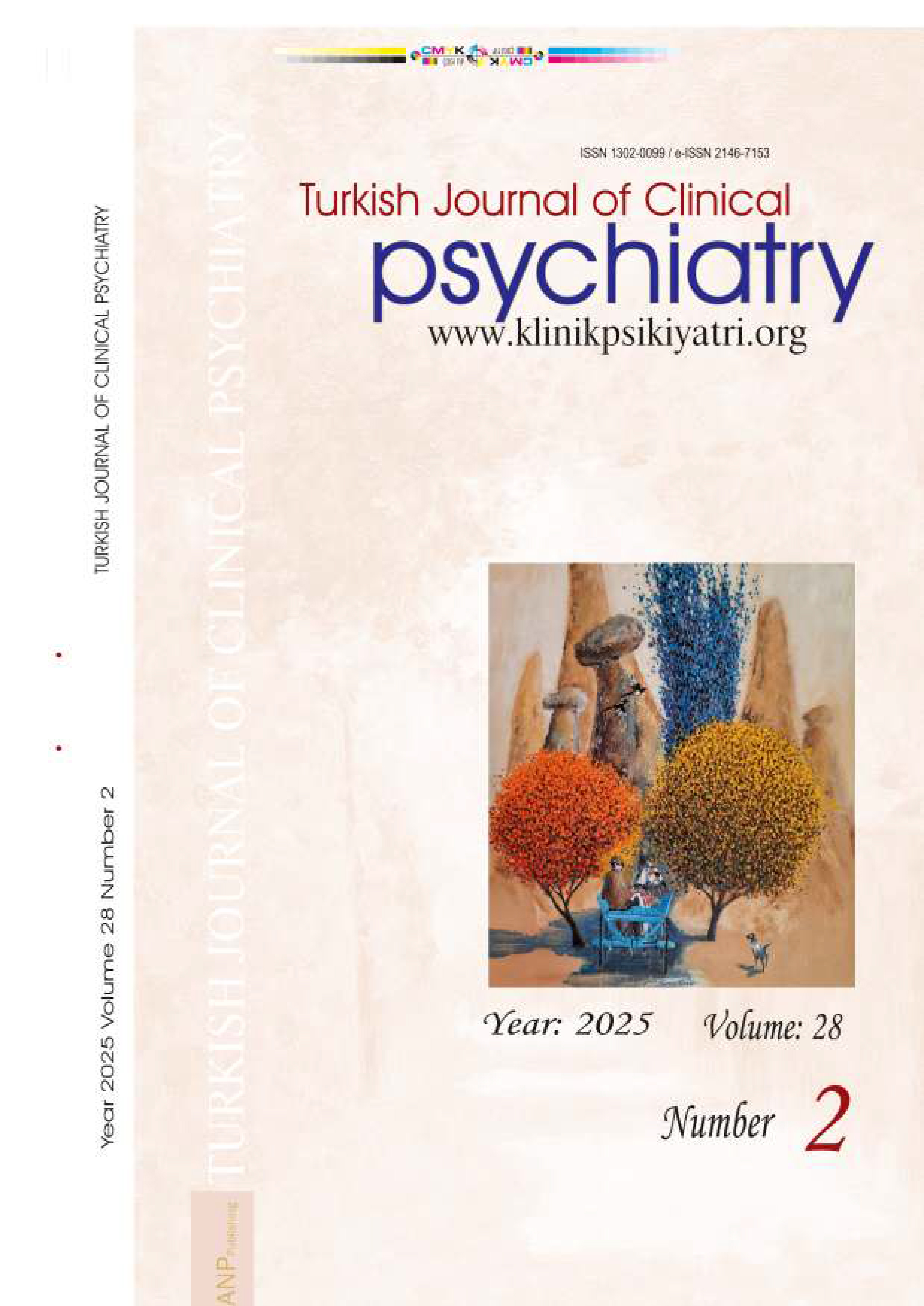





Volume: 6 Issue: 1 - 2003
| RESEARCH ARTICLE | |
| 1. | Compliance to Treatment in Depressive Patients: A Naturalistic Follow-up Study Süreyya Özel ERVATAN, Aynur ÖZEL, Hakan Türkçapar, Nuray Atasoy Pages 5 - 11 In spite of the public health burden presented by depression and the availability of medications with well demonstrated efficacy, many depressed patients remain undertreated. According to research data only 10% of patients with major depression received adequate doses of antidepressant therapy for an adequate period of time. Main factor contributing to undertreatment is nonadherence to the recomended treatment regimen, including both missed doses and early discontinuation of medication. Ninety seven major depressive patients who were recruited from outpatient clinic of SSK Ankara Residency Training Hospital entered the study. Patients were divided into two groups according to early discontinuation of medication as compliant and non-compliant group, and have been followed up for six months. These two groups were compared according to the clinical and sociodemografic features and the factors which may cause non-compliance to treatment have been investigated. When the clinical and sociodemografic characteristics of 71 compliant and 26 non-compliant patients were analysed as statistically, it has been seen that treatment compliance of women were higher significantly. Also it has been found that the patients compliant to dose regimen were more compliant to treatment and this finding statistically significant. |
| 2. | Evaluation of Symptoms of Acute Stress Disorder in Victims of Motor Vehicle Accidents M. Tayfun TURAN, Salih KELEŞ Pages 12 - 17 Motor vehicle accidents are important in occurrence of acute stress disorder and posttraumatic stress disorder. In this study we aimed to find out the occurrence rate of symptoms of acute stress disorder, and to investigate the relationships among the demographic features of patients, the severity of acute stress disorder and the characteristics of accidents in patients with moderate or severe injury following motor vehicle accidents. The study consisted of 40 moderately or severely injured inpatients following motor vehicle accidents. The clinical interview was performed by a psychiatrist on days 3-15 following accidents. Posttraumatic Stress Disorder Checklist, Impact of Event Scale, Beck Depression Inventory, State Anxiety Inventory and Abbreviated Injury Scale were used to evaluate the psychiatric symptoms and the severity of injury of the patients. Heart rates and blood pressures were assessed. Impact of Event Scale, Beck Depression Inventory, State-Trait Anxiety Inventory scores and the heart rates were significantly higher in the patients who had severe acute stress disorder symptoms than those of the patients who had lower symptoms. It was also found that Posttraumatic Stress Disorder Checklist score in the patients with severe injury was significantly higher than that in the patients with moderate injury. These findings were discussed in the light of existing literature. |
| 3. | Not All Cases Diagnosed as Anxious Depression Reveal an Underlying Depressive Disorder: A Comparative Follow-up Study Cumhur Boratav, Atıf Koç Pages 18 - 26 The present study aimed at testing the hypothesis that cases diagnosed as anxious depression may primarily reflect cases of anxiety disorder. For this purpose, 15 patients diagnosed as anxious depression and 20 patients with panic or generalized anxiety disorder were enrolled into a prospective study. The patients were given lorazepam at a dose of 1.5 mg/ day and followed up for a period of 3 weeks. At the end of the observation period, 5 patients with anxious depression were noted to have a score less than 17 according to Beck Depression Inventory. The group of patients that responded to benzodiazepine remained in a position halfway between anxiety and depression in terms of scale scores, quantity of symptoms and the rate of improvement of symptoms. The onset of symptoms in this sub-group of patients was indistinguishable from those of depression. Although our findings fail to provide a supportive evidence for the anticipated hypothesis, they suggest that at least a sub-group of depression cases remain in an indefinite position that can neither be classified as anxiety disorder nor a depressive disorder. |
| 4. | Can Medical Inpatients in Need of Psychiatric Help Be Recognized? Kemal YAZICI, Şenel TOT, Aylin YAZICI, Pervin Erdem, Visal BUTURAK, Yavuz OKYAY, Yıldırım ŞİMŞEK Pages 27 - 31 Presence of a medical illness increases the risk for any psychiatric disorder. Despite their common occurrence, psychiatric disorders are frequently underrecognised and undertreated in medical-surgical services. The objectives of this study were to determine the relationship between the opinion of medical and surgical inpatients that they needed psychiatric help and the rate of psychiatric consultations and to evaluate the symptoms of anxiety and depression. Inpatients in Hospital of Medical Faculty of Mersin University were included in the study. Patients were administered a questionnaire and Hospital Anxiety and Depression Scale. Results of239 patients (men=135, women = 104) were evaluated. The rate of patients thinking that they needed psychiatric help was 26.8% (n=64), and that of patients thinking that they did not need was 73.2% (n=175). The patients thinking that they needed help had significantly higher scores on HAD- Depression and HAD-Anxiety subscales (9.4±4.5 ve 10.9±4.8 ) compared to those thinking that they did not need help (7.1±4.4 ve 7.2±4.4). Of the total 239 patients, 14 (5.9%) were evaluated by a psychiatrist during their stay in hospital. Of the 64 patients thinking that they needed psychiatric help, only 5 (7.8%) reported that they were evaluated by a psychiatrist.Data of this study suggest that the rate of psychiatric consultations was not adequate. We think that post-graduate education of physicians, providing a suitable environment for patients to express their psychological complaints and establishing an approach based on liason model instead of conventional consultation model in general hospitals will be beneficial. |
| 5. | Comparison of Demographic and Some Clinical Characteristics of Patients with Social Phobia and Panic Disorder Hatice GÜZ, Nesrin DİLBAZ Pages 32 - 38 In this study, the socio-demographic and some clinical characteristics of patients with social phobia and panic disorder were compared. Seventy-two patients with social phobia and 51 patients with panic disorder were included in the study. Alongside a sociodemographic information questionnaire, all patients were given a Hamilton Rating Scale for Anxiety, Hamilton Depression Scale, Sheehan Disability scale, SCL-90 symptom checklist, Anxiety Sensitivity Index. In our sample, social phobia was more frequent in males, singles, and participants with higher education levels and adolescents with school phobia than the panic disorder, and also the period of illness was longer in patients with social phobia (p<0.05). The scores of Hamilton Depression Scale, Hamilton Rating Scale for Anxiety and function lose in the area of home and family of Sheehan Disability scale were higher in patients with panic disorder than the patients with social phobia (p<0.05). The somatization, obsession-compulsion, depression, anxiety, anger-hostility, paranoid ideation, psychoticism and total scores of SCL-90 were higher in the patients with panic disorder (p<0.05).In the light of these findings, although both of the disorders are anxiety disorders, panic disorder is thought to be more severe than the social phobia. |
| 6. | Empathy-Objectivity Dilemma in Psychotherapy M. Haluk Özbay, Banu Işık CANPOLAT Pages 39 - 45 The objective of this paper is to discuss the place of empathy and objectivity in psychotherapy. Furthermore, it is also addressed whether empathy and objectivity create a dilemma for psychotherapist. Most of researchers suggest that the empathy is a special identification form that is characterised by a transient, consciously or preconsciously determined, nonregressive and easily reversible nature. The phenomenon conceptualised by the emphatic understanding is always within the interpersonal context and is a belief rather than a knowledge. A psychotherapist must use his own psychology during therapy, which requires that he should know his psychology thoroughly. Other than this, the analyst's opinion is always a different reality though it may not be a more accurate reality in all circumstances. The psychotherapist should use a scientific method or technique to get valid knowledge about the patient. Empathy presents to the therapist an unverified knowledge. For this reason, empathy alone cannot be used as a method in psychotherapy and it is not required in all psychotherapy sessions nor the therapist should actively use it. In most of the discussions on the objectivity and subjectivity, the term "object" which is the root of the term "objectivity" is often ignored. The meaning of this term is something external to the cognitive mind or subject. It is impossible for a human being to be objective due to his or her nature. That is only the science that can be objective. The therapist should not to be worried about making empathy or being objective. |
| REVIEW | |
| 7. | Psychoanalytic Views on Obsessive-Compulsive Disorder Volkan Topçuoğlu Pages 46 - 50 The aim of this article is to review the psychoanalytic views on Obsessive Compulsive Disorder. The explanations of Freud on obsessional neurosis are presented thoroughly and then modern psychoanalytic theories on this disorder are given in chronological order. Additionally, the conditions where psychoanalytic treatment are appropriate are outlined. |
| 8. | Schizophrenia: Estrogen and Brain Sermin KESEBIR, Şebnem PARILDAR Pages 51 - 55 The neuroendocrine changes that occur in specific areas of the basal forebrain during the reproductive period are reviewed in relation to reported anatomic, molecular and biochemical pathologies of schizophrenia. Onset of schizophrenia occurs during the reproductive period in frequent of those affected. There is flood of estrogen and testosterone to the brain and body during puberty and throughout the reproductive period. In addition to this gonadotropic and gonadal hormones in limbic system and hyphothalamus are highly in concentration. Inequilibrium of focal inhibition mechanism due to increase in the release of inhibitory neurotransmitters in basal forebrain or increase in the number of the receptors could be effective in the emergence of the schizophrenia in susceptible individuals. Estrogen withdrawal may be risk factors for the psychosis. Topic of this paper is on possible etiopathogenetic and pathophysiologic relationships between schizophrenia and estrogen. |
| CASE REPORT | |
| 9. | Two Sisters with Anorexia Nervosa: Case Report Burhanettln Kaya, Duygu YIGİTTÜRK, H. Dilek YALVAÇ Pages 56 - 61 Although anorexia nervosa (AN) has been known for years, it has been started to be more researched and more paid attention for recent years. High proportion at women, beginning at the age of adolescence, the role of family conflict in forming disorder, and familial loading have been increased discussion devoted to etiology. It is cleared that AN is needed more research about basis of neurobiology, the behavioral genetic, the family dynamics, sociocultural characteristics, psychosexual development and cognitive-behavioral aspects. The effects of globalization on human body and psyche caused the eating problems are become widespread, not only in high socioeconomic level, but also all socioeconomic and cultural levels. In this article, two sisters of AN cases showing different clinic features has been discussed in the light of literature. |










